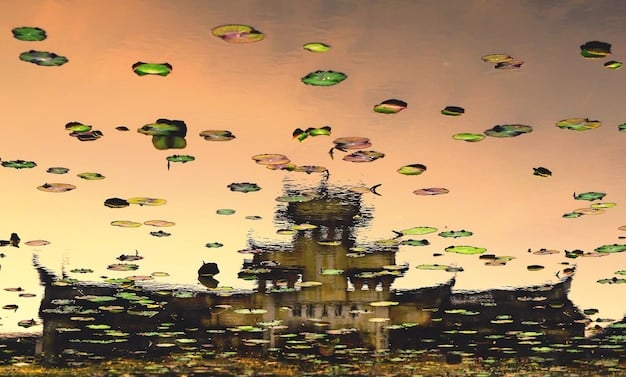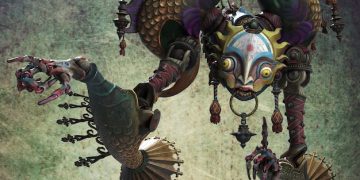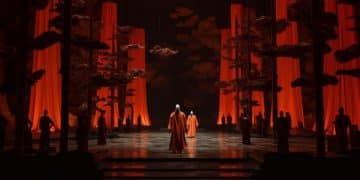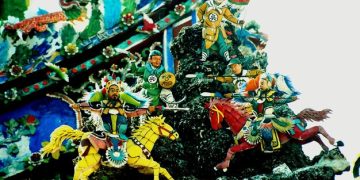Chinese Drama Genres: Xianxia, Romance & The Ultimate Guide

Advertisements
Chinese dramas encompass a wide array of genres, from historical epics and fantastical xianxia to modern-day romances and family dramas, each offering unique narratives and cultural insights.
Dive into the captivating world of Chinese dramas with **the ultimate guide to understanding Chinese drama genres: from Xianxia to Modern Romance**. Discover the unique characteristics, cultural nuances, and compelling narratives that make each genre a beloved form of entertainment.
Anúncios
A World of Stories: Exploring Chinese Drama Genres
Chinese dramas, often referred to as C-dramas, have gained immense popularity worldwide, captivating audiences with their diverse storytelling and rich cultural portrayals. But with so many genres available, it can be overwhelming to know where to start. This guide explores the most popular Chinese drama genres, providing you with a roadmap to navigate this exciting world.
What Makes Chinese Dramas Unique?
Before diving into specific genres, it’s important to understand what sets Chinese dramas apart. Several key elements contribute to their distinct appeal:
Anúncios
- Cultural Immersion: C-dramas offer a window into Chinese culture, traditions, values, and history, allowing viewers to experience a different way of life.
- Elaborate Costumes and Sets: From historical dramas with their imperial robes to xianxia fantasies with ethereal gowns, the visual aesthetics are often stunning and meticulously crafted.
- Complex Storytelling: Chinese dramas are known for their intricate plots, character-driven narratives, and emotional depth.
- Strong Female Leads: Many modern C-dramas feature strong, independent female characters who challenge societal norms.
Understanding these elements will enhance your appreciation for any genre you choose to explore.

Xianxia: The Realm of Immortals and Magic
Xianxia, often translated as “immortal heroes,” is a genre heavily inspired by Chinese mythology, Taoism, and martial arts. These dramas typically involve characters who cultivate spiritual energy to achieve immortality and godhood, battling demons and overcoming trials along the way.
Key Elements of Xianxia Dramas:
- Cultivation: The central theme revolves around the process of cultivating spiritual energy (qi) to ascend to higher realms of power.
- Immortals and Demons: Characters often interact with deities, demonic entities, and mythical creatures.
- Magical Artifacts: Powerful swords, mystical elixirs, and other enchanted objects play a significant role in the storyline.
- Love Triangles: Romantic relationships are often intertwined with destiny and power struggles.
Popular Xianxia Dramas: “Eternal Love (Ten Miles of Peach Blossoms),” “Ashes of Love,” and “The Untamed.” These dramas offer visually stunning worlds and epic stories of love, loss, and the pursuit of immortality.
Wuxia: Martial Arts and Heroic Adventures
Wuxia dramas focus on martial artists (xia) who uphold justice and roam the jianghu, a fictional martial arts society. These stories emphasize chivalry, honor, and the fight against oppression.
Distinguishing Features of Wuxia:
- Martial Arts Prowess: Characters possess extraordinary combat skills and often demonstrate superhuman abilities.
- Jianghu Society: A complex world of martial arts schools, sects, and wandering heroes governs the social dynamics.
- Revenge and Redemption: Many narratives revolve around quests for vengeance, self-discovery, and moral growth.
- Brotherhood and Loyalty: Strong bonds of friendship and unwavering allegiance are crucial aspects of wuxia stories.
Iconic Wuxia Dramas: “The Condor Heroes,” “Smiling Proud Wanderer,” and “Nirvana in Fire.” These dramas showcase breathtaking fight choreography and timeless tales of heroism.
Historical Dramas: Glories and Intrigues of the Past
Historical dramas transport viewers to different dynasties and eras of Chinese history, depicting the lives of emperors, concubines, generals, and commoners. These dramas often explore themes of power, betrayal, loyalty, and sacrifice.
Hallmarks of Historical Dramas:
- Lavish Court Politics: Schemes, alliances, and power struggles within the imperial court are central to the plot.
- Romance and Harem Intrigue: Love stories are often set against the backdrop of the imperial harem, filled with jealousy and ambition.
- Historical Accuracy (to varying degrees): While dramas are fictional recreations, they often incorporate real historical events and figures.
- Cultural Traditions and Customs: Viewers are immersed in the clothing, etiquette, and social norms of the depicted era.
Highly-Rated Historical Dramas: “Empresses in the Palace,” “Story of Yanxi Palace,” and “Ming Dynasty.” These dramas excel in their production values and compelling character development.
Modern Romance: Love in the Contemporary World
Modern romance dramas depict the romantic relationships and personal struggles of characters living in contemporary China. These dramas often tackle issues such as career ambitions, family expectations, and the challenges of modern love.
Defining Characteristics of Modern Romance Dramas:
- Relatable Characters: Viewers can easily identify with the everyday lives and emotional experiences of the protagonists.
- Career and Workplace Dynamics: Many stories are set in professional environments, exploring the challenges of balancing work and romance.
- Family Issues and Expectations: Parental pressure and societal norms often influence romantic choices.
- Fashion and Lifestyle: Modern romance dramas showcase the latest trends in fashion, technology, and urban living.
Popular Modern Romance Dramas: “Love O2O,” “Go Go Squid!,” and “Put Your Head on My Shoulder.” These dramas offer lighthearted entertainment and relatable relationship dynamics.

Family Dramas: Exploring Intergenerational Relationships
Family dramas delve into the complexities of intergenerational relationships, exploring themes of family loyalty, tradition, and the challenges of balancing individual desires with familial obligations. These dramas often depict realistic portrayals of Chinese family life.
Key Aspects of Family Dramas:
- Generational Conflicts: The clash between traditional values and modern aspirations often creates tension within families.
- Parental Expectations: Children often face intense pressure to succeed academically and professionally.
- Filial Piety: The importance of respecting and caring for elders is a recurring theme.
- Realistic Portrayals of Daily Life: Family dramas often depict the everyday struggles and joys of ordinary Chinese families.
Well-Received Family Dramas: “Ode to Joy,” “Go Ahead,” and “A Little Reunion.” These dramas provide a nuanced look at contemporary Chinese family dynamics.
Suspense and Crime: Thrilling Mysteries and Investigations
Suspense and crime dramas have gained popularity in recent years, offering thrilling narratives filled with mystery, intrigue, and complex investigations. These dramas often explore the darker aspects of society.
What Defines Suspense and Crime Dramas:
- Intricate Plotlines: Complex mysteries and unpredictable twists keep viewers on the edge of their seats.
- Skilled Investigators: Detectives and other law enforcement professionals are central to the storytelling.
- Moral Ambiguity: Characters often grapple with difficult ethical choices.
- Social Commentary: Many dramas address contemporary social issues, such as corruption and inequality.
Critically-Acclaimed Suspense Dramas: “The Bad Kids,” “Burning Ice,” and “Day and Night.” These dramas push boundaries with their dark themes and suspenseful storytelling.
| Key Highlights | Brief Description |
|---|---|
| ✨ Xianxia | Immortals, cultivation, and magical realms. |
| ⚔️ Wuxia | Martial arts heroes navigating a chivalrous world. |
| 📜 Historical | Dynasties, court politics, and period romances. |
| ❤️ Modern Romance | Contemporary love stories and workplace dramas. |
Frequently Asked Questions (FAQ)
▼
Xianxia involves cultivation towards immortality, often with gods and demons. Wuxia focuses on martial artists upholding justice, typically without supernatural elements.
▼
Historical dramas are fictionalized accounts, incorporating historical events and figures but often taking creative liberties for narrative purposes.
▼
Popular streaming platforms like Viki, Netflix, and YouTube offer a wide selection of Chinese dramas with English subtitles for international viewers.
▼
Their relatability, focusing on contemporary issues like career ambitions, family pressures, and the challenges of modern relationships, resonates with viewers.
▼
Yes, family dramas are very popular, exploring intergenerational relationships, filial piety, and the balance between individual desires and family obligations.
Conclusion
Chinese dramas offer a rich tapestry of genres to explore, each providing a unique cultural experience and compelling storytelling. From the fantastical realms of Xianxia to the realistic portrayals of modern romance, there’s a C-drama out there for everyone. Delve into these diverse genres and discover your next favorite addiction.





